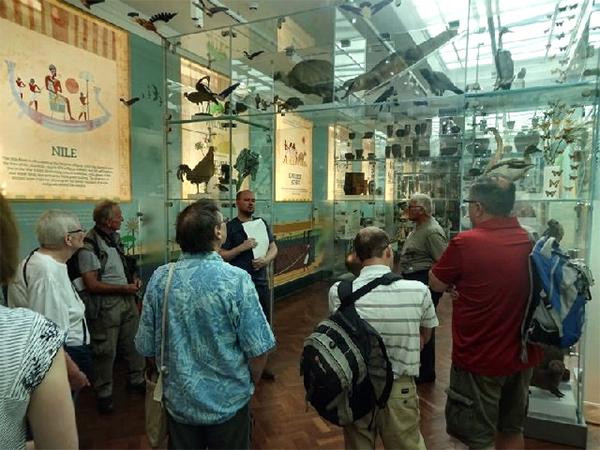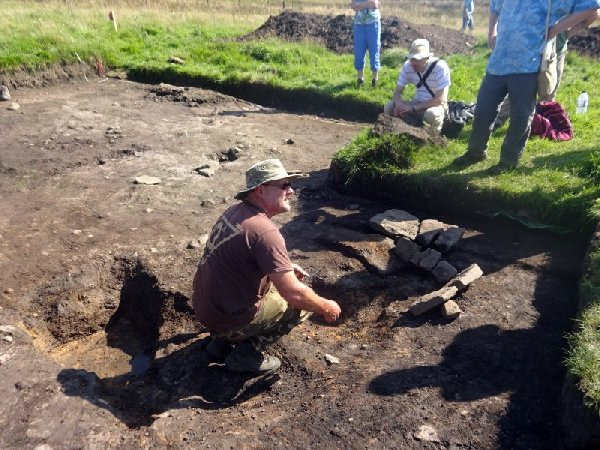
It's great to have a member of your Society who is also the curator of a nationally important museum. Ian Trumble's guided tour, therefore, around Bolton's Egyptian Galleries last month was bound to be good. Ian began by explain the origins of the collections which are spread across the 6 halls on the first floor. In 1884, a Museum of Natural History was opened in the Queen's Park, bequeathed by philanthropist Dr Samuel Chadwick who had died in 1876. It soon filled with artefacts from around the world but particularly Egypt. This was because Bolton's mill owners had been obliged to switch their cotton supply due to the American Civil War blockade. They soon became active supporters for all things Egyptian, even raising money for excavations. When the collections outgrew the Chadwick halls in 1956, the whole lot was moved to the newly erected Crescent building behind the town hall. In 2013, in recognition of its importance, the Museum got a HLF grant toward redevelopment of its Egyptian Gallery. The following year, Bolton Council added a further £3.8m. The result is quite stunning. Cleverly arranged in chronological and typological order, it tells the story of Egypt from the pre-dynastic period right through to the Greek and Roman eras. In the textile hall, Bolton is boasting the oldest known piece of cloth in the world.
The final pièce de résistance is a full-scale recreation of the tomb of Thutmose III. Found in 1898, this tomb (KV34) famously has the complete text of the New Kingdom's funerary rites depicted on its walls. To help you to follow this infinitely complicated daily ritual, an entertaining animation is screened on the walls every 10 minutes.

After lunch, we headed off to Holcombe Moor where we were met by Neil Coldrick, of the Holcombe Moor Heritage Group. After guiding us along a rough track onto the moor, Neil showed us the remains of an early 19th C water mill which they had spent 5 years uncovering. It was described as Cinder Hill Engine House on early maps but it was unclear exactly what its function was. It was certainly water powered, located as it is at the foot of a mill dam, and the excavations had also exposed the wheel pit. Artefacts recovered, including rollers for pulling raw cotton, suggest it was a spinning operation (or were they just making these items?) Neil then guided us across the brook and up the over side of the valley to their more recent excavations. During their work at the mill, charcoal, iron slag even ore, together with medieval pottery, had been turning up in the valley over the years but the exact source was unknown. As this is MOD land, the ground had to be swept for residual ordinance before any investigations could begin. It was during this operation that a large signal was detected, but instead of an unexploded shell or mortar, the soldiers uncovered what turned out to be the remains of an ancient bloomery furnace. C14 dating results were quite astonishing as from the surrounding area 1027-1182 cal AD and from the bloomery itself, late Saxon. If it can be confirmed, it means this is quite a remarkable site. Neil will be visiting us in November to present more details but in the meantime there's more of our trip here.
On our way home, we decided to pay a visit to the medieval roadside cross at Affetside. It's on the Roman road from Manchester to Ribchester, and some even claim it to have a Roman origin. Nevertheless, the recently constructed Millennium Green behind it, with its picturesque fish pond, provided a very pleasant end to a very enjoyable day.
Next Meeting
Wednesday 4th September - at our new venue The Bellingham (7.30pm as usual). This month we will be having our very own Mike Keulemans talking about his investigations into the archaeology of circular (or curvilinear) churchyards. Mike is a semi-retired vicar who gained his doctorate while serving as a priest in mid Wales. The subject of his thesis was the now defunct church of St Melangell in Pennant which has a very distinct circular graveyard. There are well over a hundred of these recorded in Wales and Mike suspects they have a Celtic or even earlier origin. Strangely though, studies of this type of graveyard have not been conducted beyond the Welsh borders but Mike has noticed perhaps a dozen or more in the South West Lancs area alone. It's a fascinating subject and much food for thought - hope to see you there BA
|



